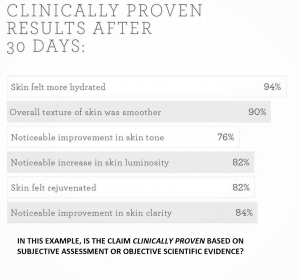The last fifty years in the history of cosmetics as a means to beautify and improve skin characteristics, have seen an increasing interest in investigating the actual effects of cosmetic products on the skin. As a result of such interest, since the 1990’s, there have been several non-invasive methods and instruments that have been developed to “measure” in vivo the outcomes of topical cosmetic preparations and the likelihood of them improving certain skin conditions.
SKIN CARE EFFICACY STUDIES
Thanks to technological advancements and a deeper understanding of the biological components of the skin, cosmetic treatments can now be assessed for efficacy in improving various skin problems. Typically hydration, wrinkles, skin tone, blemishes etc. are common concerns; and the products marketed to people with those concerns are often the subject of efficacy trials.
COLOUR COSMETICS
Skin care treatments are not the only cosmetics. Another group of cosmetics that are extremely popular are colour cosmetics. Colour cosmetics consist of products containing colour pigments that are intended to temporarily alter the user’s appearance. In Australia, colour cosmetics belong to a sub sector continuing to experience market growth (together with hair care and beauty salon products)1. When it comes to lipstick, mascara, blush, concealer etc., is there a way to assess their performance? What is the best way to evaluate whether they are appropriate for their function or how they perform compared to other brands?
DIFFERENCES
The main difference between assessing skin care products and colour cosmetics is that some skin care products can fail in providing the benefit they claim in the market whilst this is almost never the case for colour cosmetics. While with skin care products there is a huge variety of formulations that allow a wide range of finished products that go from poor quality to some very high quality ones, with colour cosmetics the difference between various brands are mainly associated with sensory and visual aspects. In the skin care product category let’s take as an example products that are marketed as moisturisers. You can still find on the market some very poorly formulated products that are may not significantly improve skin hydration. On the other side, it is possible to find products that will moisturise your skin for hours even after a single application.
A MASCARA IS A MASCARA
With colour cosmetics, the differences between various brands may not be as apparent or measurable. Nearly all colour cosmetics can deliver similar benefits. The actual effect of a colour cosmetic, which is colouring, beautifying and enhancing, is almost always achieved by any product. For example, there are good chances that any mascara with its applicator brush will colour, curl, lengthen and thicken eyelashes and is therefore fit for the purpose. Nevertheless there are some differences between different products or brands.
VISUAL AND SUBJECTIVE ASSESSMENTS
Since the function of colour cosmetics is to temporarily colour the skin surface, the best way to evaluate their performance is through visual assessment. Digital photos taken at different intervals and subsequent image analysis would be one of the best ways to represent the effect of these products over time. However, the ease of application, the way the product spreads evenly, whether it smudges or not, are also elements of interest to consider in assessing a product’s performance. Therefore, in a trial where participants use the product for either a short or long time, it is important to include interviews or questionnaires to assess certain product characteristics. A control in the form of a comparative product (e.g. competitor’s product) in this case is essential both for the digital photographs and the subjective questionnaire.
COLOUR COSMETICS AND THE SENSES
These types of assessments may provide some elements to enable evaluation and comparison of the performance of colour cosmetics. Although it is not expected that there will be remarkable intrinsic differences between various brands of colour cosmetics, some elements that some people may view as secondary (e.g. packaging, precision in the application of the colour cosmetic, advertising) might be considered of greater value to some consumers. Therefore in the area of colour cosmetics, even more than with skin care cosmetics, the success of a brand may depend on a targeted marketing strategy, which may need to focus mainly on sensory aspects.
1 Cosmetics & Toiletries Market Overviews 2015, Compiled by U.S. Commercial Service Hong Kong, page 6.




